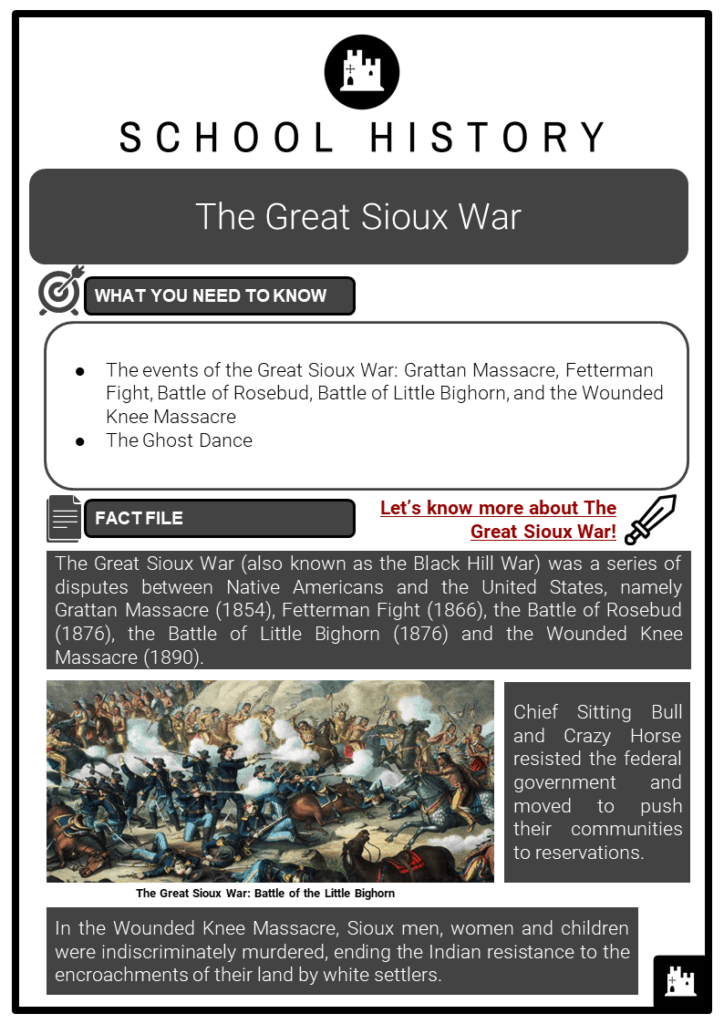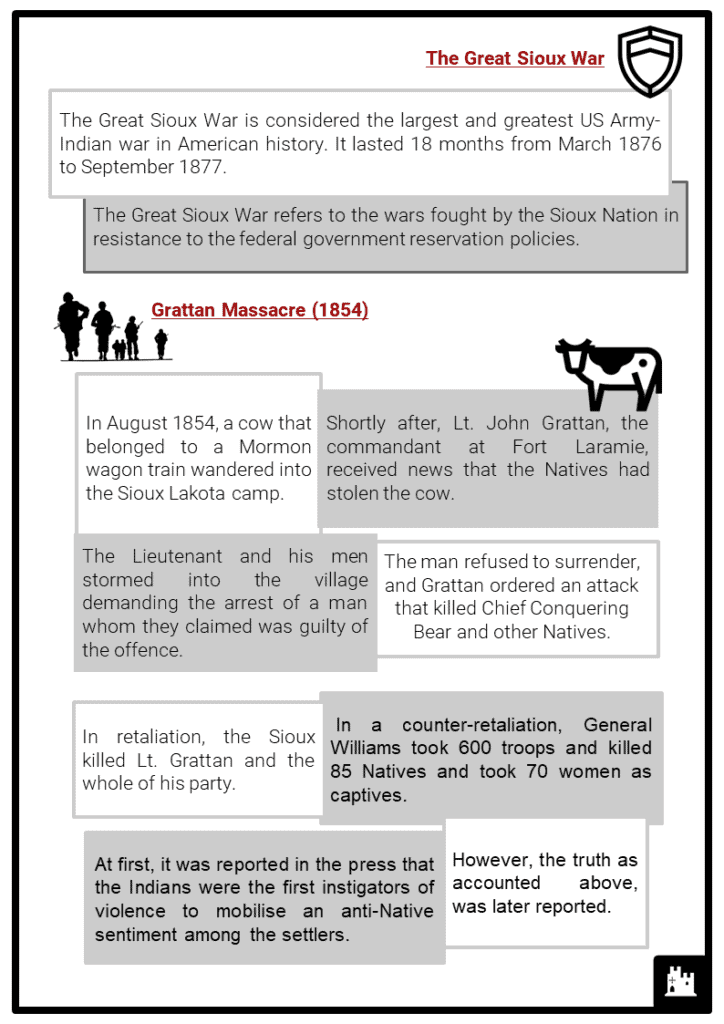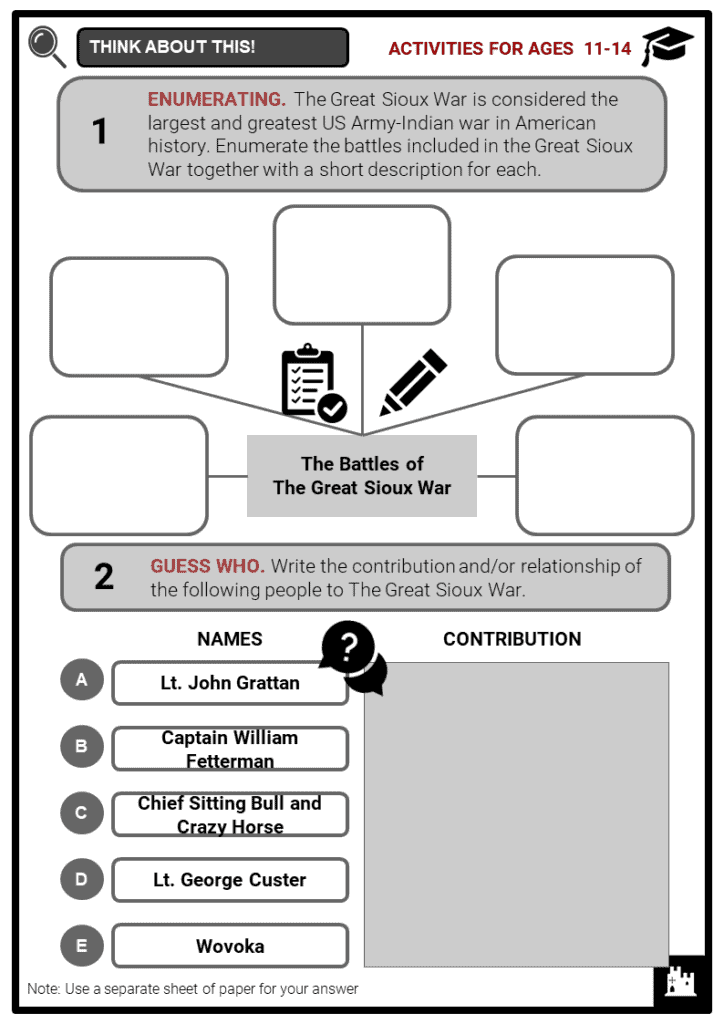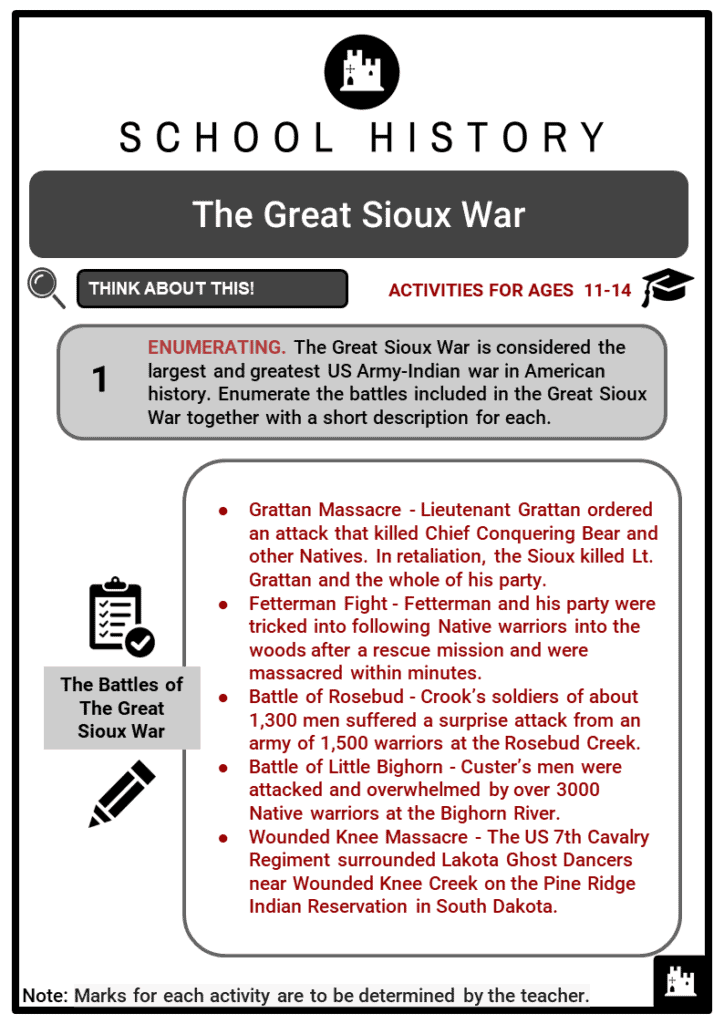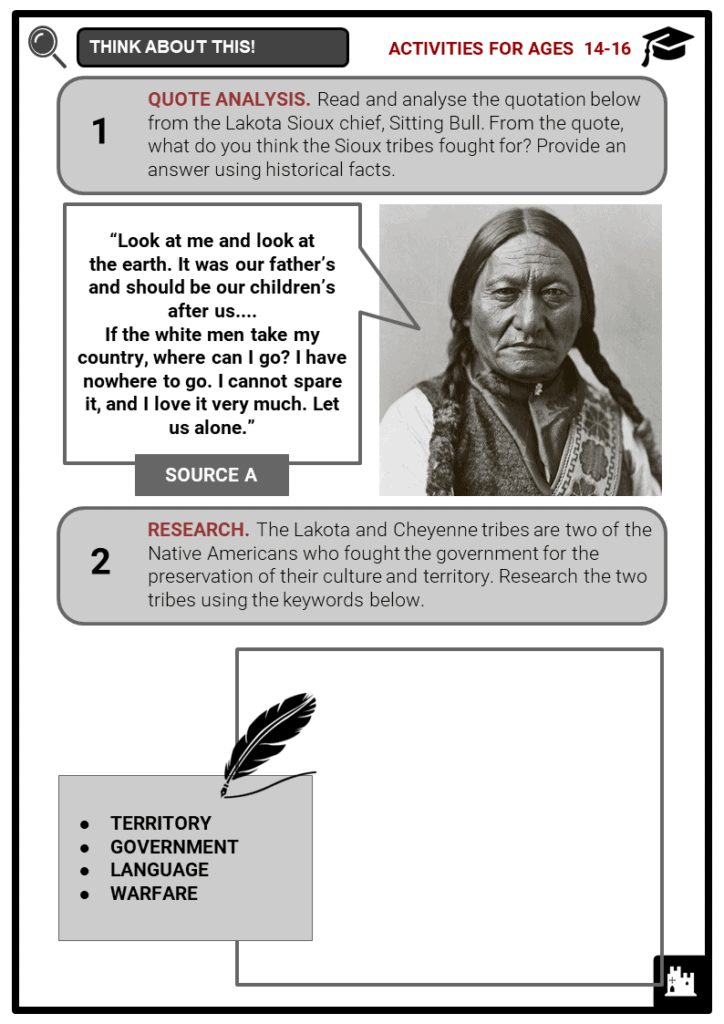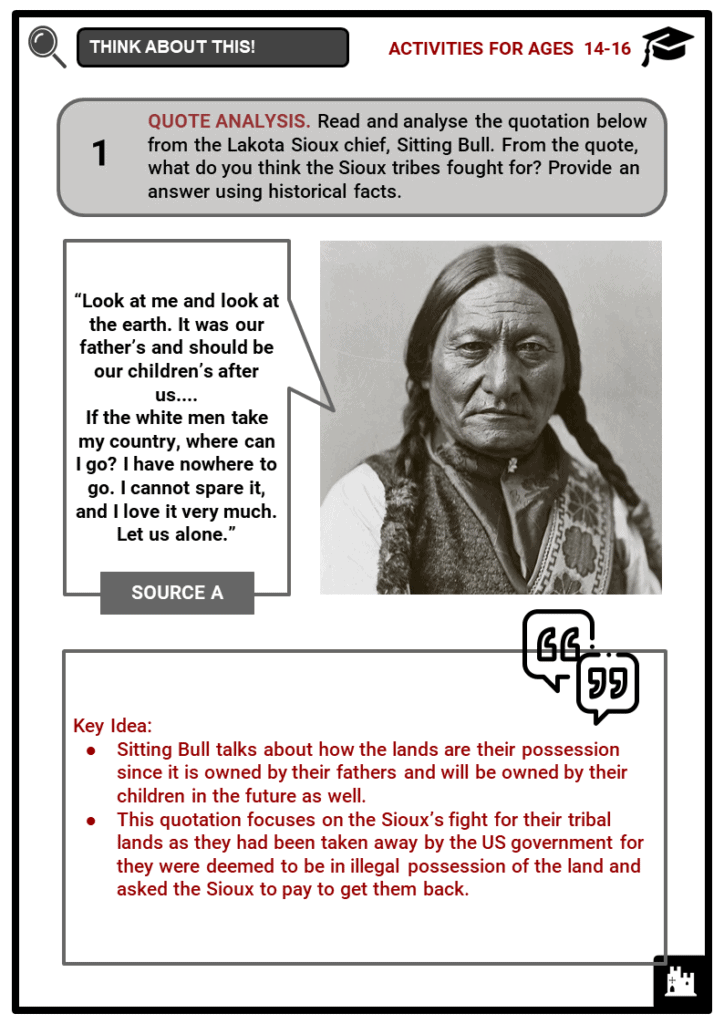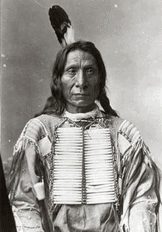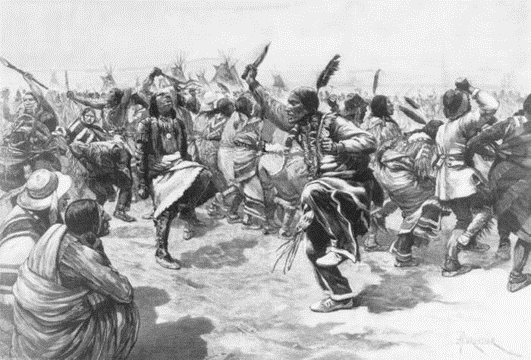Download The Great Sioux War Worksheets
Do you want to save dozens of hours in time? Get your evenings and weekends back? Be able to teach The Great Sioux War to your students?
Our worksheet bundle includes a fact file and printable worksheets and student activities. Perfect for both the classroom and homeschooling!
Table of Contents
Add a header to begin generating the table of contents
Summary
- The events of the Great Sioux War: Grattan Massacre, Fetterman Fight, Battle of Rosebud, Battle of Little Bighorn, and the Wounded Knee Massacre
- The Ghost Dance
Key Facts And Information
Let’s know more about The Great Sioux War!
- The Great Sioux War (also known as the Black Hill War) was a series of disputes between Native Americans and the United States, namely Grattan Massacre (1854), Fetterman Fight (1866), the Battle of Rosebud (1876), the Battle of Little Bighorn (1876) and the Wounded Knee Massacre (1890).
- Chief Sitting Bull and Crazy Horse resisted the federal government and moved to push their communities to reservations.
- In the Wounded Knee Massacre, Sioux men, women and children were indiscriminately murdered, ending the Indian resistance to the encroachments of their land by white settlers.
The Great Sioux War
- The Great Sioux War is considered the largest and greatest US Army-Indian war in American history. It lasted 18 months from March 1876 to September 1877.
- The Great Sioux War refers to the wars fought by the Sioux Nation in resistance to the federal government reservation policies.
Grattan Massacre (1854)
- In August 1854, a cow that belonged to a Mormon wagon train wandered into the Sioux Lakota camp.
- Shortly after, Lt. John Grattan, the commandant at Fort Laramie, received news that the Natives had stolen the cow.
- The Lieutenant and his men stormed into the village demanding the arrest of a man whom they claimed was guilty of the offence.
- The man refused to surrender, and Grattan ordered an attack that killed Chief Conquering Bear and other Natives.
- In retaliation, the Sioux killed Lt. Grattan and the whole of his party.
- In a counter-retaliation, General Williams took 600 troops and killed 85 Natives and took 70 women as captives.
- At first, it was reported in the press that the Indians were the first instigators of violence to mobilise an anti-Native sentiment among the settlers.
- However, the truth as accounted above, was later reported.
The Fetterman Fight (1886)
- Fort Phil Kearny was one of the forts on Bozeman Trail to the Montana gold fields, meant to protect the settlers from the Native American attacks.
- During the Red Cloud War, against the Crow Indians led by Chief Red Cloud and Crazy Horse, the Indians’ military tactic was guerrilla warfare.
- Through the tactics, the Indians were able to undermine the strong federal armies by irregular ambush attacks of the troops when they were least prepared.
- Captain William Fetterman was sent to Fort Phil Kearny to support Colonel Carrington.
- Fetterman strongly criticised Carrington’s tactics and spoke in contempt of the Indians’ fighting ability, bragging that with ‘his skills could ride through the entire Sioux nation with 80 men.’
- At the same time, Red Cloud’s army started mocking the troops at Fort Phil Kearny, attempting to lure them into ambushes using decoys and attempts to provoke and enrage the troops.
- They failed on several occasions, but succeed in the end.
- Fetterman and his party were tricked into following Native warriors into the woods after a rescue mission and were massacred within minutes.
Battle of Rosebud (1876)
- In 1875, the discovery of gold in the South Dakota Black Hills made the federal government under President Ulysses Grant try to once again move the Sioux people against the terms of the second Treaty of Laramie 1868.
- The Sioux Nation refused to vacate the Black Hills land which they considered sacred.
- The Lakota and the Cheyenne left the reservations to join Chief Sitting Bull and Crazy Horse in Montana to defend the sacred lands.
- By the spring of 1876, more than 10,000 Native Americans had camped along River Little Bighorn against the orders of the government to return to their reservation.
- The US Army organised itself into three columns and planned to gather on the valley of the Bighorn River in the southern region of Montana to front an attack against the Natives, now labelled hostile owing to their refusal to stay in reservations though they were not exactly sure of their exact location.
- General George Crook was commander of one of the columns and was to head out north from Fort Fetterman in Wyoming to join General Gibbon’s column coming east from Fort Ellis in Montana and General Terry’s force which included the 7th Cavalry under the command of Lieutenant George Custer approaching west from Fort Abraham Lincoln in Dakota.
- As Crook and his column approached the Rosebud Creek, east of the Bighorn, he received word that the Sioux force was nearby.
- Without evidence, he was convinced that the Sioux were camped in a village along the Creek and believed that they would flee rather than stand and fight. He was determined to attack before they fled to the nearby woods.
- However, his informants, 262 Crow and Shoshone warriors were not sure of Crook’s conviction and believed that the Natives were under the instructions of Chief Horse who was excellent in battle, to set up a village with an imminent attack from the army.
- In one morning, when Crook’s soldiers of about 1,300 men were relaxing in the morning breeze, they suffered a surprise attack from an army of 1,500 warriors.
- Fortunately for Crook and his men, his Native informants were about 500 metres ahead, alert fearing a surprise attack from Chief Crazy Horse, and came to their rescue before the Sioux could do much harm to Crook’s column. 28 men were killed, 56 wounded and the stage had been set for the Native victory in the Battle of Little Bighorn.
Battle of Little Bighorn (1876)
- Five days after the Battle of Rosebud, General Alfred ordered Custer’s Cavalry to scout ahead for enemy troops.
- Approaching the enemy camp at Bighorn river, Custer decided to press ahead with his 600 men as opposed to waiting for reinforcements.
- The Natives got word of the impending attack and Sitting Bull rallied warriors and escorted the women and children away from the battle while Crazy Horse set off with a large force to meet the army.
- Within hours, all of Custer’s men were attacked and overwhelmed by over 3000 Native warriors.
- The Battle of Little Bighorn was among the most decisive victories the Natives had over the federal government army.
- However, in response to the fight, the federal government increased its presence and troops in the region and within five years, the Natives had been pushed into reservations.
- The Native population declined significantly over time.
- Some Native leaders sought to revive the Native culture and spiritual practices to reassert their sovereignty.
- Among the emerging religious tradition at the time was the Ghost Dance.
Wounded Knee Massacre (1890)
The Ghost Dance
- Wovoka, a spiritualist of the Northern Paiute tribe, claimed on 1 January 1889 to have had a vision during which God appeared to him, in the guise of a Native American and revealed to him a productive land of love and peace.
- He founded the Ghost Dance movement and promised the reuniting of Indian tribes of the West and South West and the purging of evil in the world.
- During the Ghost Dance, men and women would stand in a large circle while others danced in the centre of the ring.
- Wovoka had taught that the Ghost Dance ceremony enables the living to draw power from the spirit of the dead to overcome in battle the white settlers and the US Army.
- The prophecy of the Ghost Dance that the Natives would eventually defeat the settlers and the American army significantly propelled resistance to the reservations and consequently the realisation of the manifest destiny.
- Chief Sitting Bull had been in and out of resistance battles since the Battle of Little Bighorn, including fleeing to Canada. He was not a Ghost Dancer, but he did not discourage the practice among those who looked to him for leadership.
- On 15 December 1890, he was killed by reservation police who mistakenly confused him for a Ghost Dancer.
The Massacre at Wounded Knee
- Two weeks later, the US 7th Cavalry Regiment surrounded Lakota Ghost Dancers near Wounded Knee Creek on the Pine Ridge Indian Reservation in South Dakota.
- In an attempt to disarm the Natives, a shot was accidentally fired, though it is not known from which side, causing a scuffle.
- The army opened fire and indiscriminately killed all the men, women and children. One of those killed was Sitting Bull.
- The massacre was later reported as a battle, and the official army inquiry absolved the army of any wrongdoing and they were given Medals of Honour.
- The remaining Native communities were subdued since then, with few and insignificant resistance put up after Wounded Knee.
Image sources:

